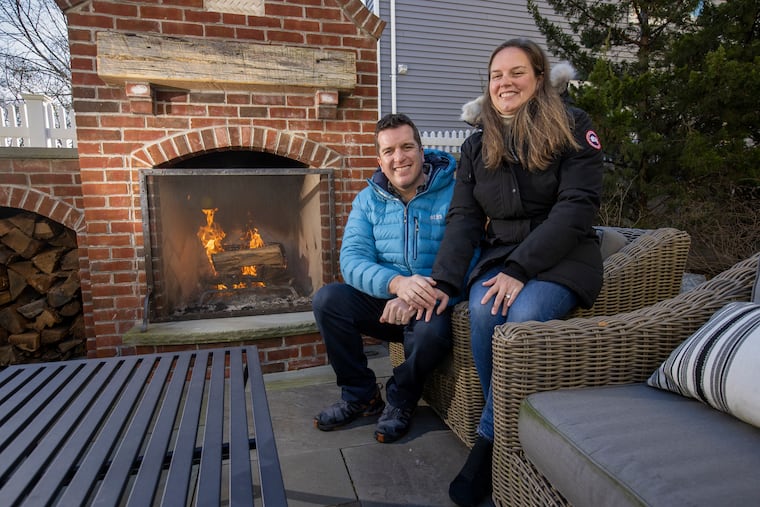Haddonfield couple’s new outdoor kitchen and fireplace help them cope with the pandemic
“Our goal was to create our own little oasis where we could have privacy to entertain and a space to escape," said a Haddonfield homeowner.

When Dan and Emily Bills built a new home in Haddonfield in 2014, they knew they wanted more privacy in their backyard. Their front porch would be a place to greet the neighbors, but out back, they wanted space for themselves.
“The houses are very close together — so much so that I can probably watch my neighbor’s television from my house,” Dan joked. “Our goal was to create our own little oasis where we could have privacy to entertain and a space to escape. We love to cook and be outdoors all year round.”
In 2019, they began the two-year project, building a fence around the 75- by 80-foot property, in some places covered with large plantings. The yard features a kitchen with a brick fireplace, bar, and seating areas surrounded by flowering plants and a play area for their daughter Caroline.
Adding to their privacy, panels separate the space from the driveway and the fireplace creates a visual barrier. The project was especially important once the pandemic hit, Dan said.
“In the early stages we weren’t seeing anybody, but at least we could be outside, having a fire, cooking and putting a movie on,” he recalled. “The only place we could go was the backyard.”
» READ MORE: Nine improvements that can help you get more out of your outdoor space
The pandemic pushed everyone outside, and as the old saying goes, fences make great neighbors, said Steve Chepurny, president of Beechwood Landscape Architecture Construction in Southampton Township, who created the Billses’ project.
And not just fences. Evergreen trees or shrubs, a vine-covered pergola, an outdoor screen and shade structure are among the many ways to create intimate spaces and separation from neighbors.
Outdoor projects have been increasing in popularity over the last few years, according to Houzz, a home improvement website. According to the 2021 Houzz & Home Study, which surveyed more than 75,000 site users, 57% of respondents created an outdoor upgrade.
Planning is essential when designing your outdoor space, Chepurny stressed. You may not be able to afford to do it all at once, but you can phase into it. Consider how long you plan to be in the home and what your overall budget will be. Perhaps you have $5,000 to spend now, but your vision may cost $15,000 over three years. A plan will allow you to get to the goal without having to make changes along the way.
“Just like the interior of your house has different rooms, we try to define exterior rooms outside,” he said. “I hate when people have already made a substantial investment, and I have to tell them they chose the wrong spot for a plant. Plants aren’t like furniture. They might need sun vs. shade, and you have to know what it’s going to look like in five to seven years.”
Privacy options exist for every budget. Pressure-treated or stained lumber products and lattice screening create barriers that are more economical. Lattice, however, requires maintenance and may not offer a long-term solution. Before the pandemic, wood and vinyl fences were most popular, said Anthony Plata, production manager at Northeast Fence & Iron Works in Northeast Philadelphia.
“Then all material costs went up drastically, but mostly wood,” Plata said. “That led people more to vinyl.”
Though pricier, their Westmoreland II line of ornamental tubular steel fencing is manufactured on-site, avoiding the long lead times in getting aluminum product. Other popular fencing options include their Deon series, which uses a custom colored vinyl board with steel framework, or Simtek product, a molded privacy fence resembling a stone wall.
Philadelphia has a six-foot height restriction for fencing, which might preclude a homeowner from using it, especially on a hilly property. Plantings may be a better option because they can grow much higher, vary in price by type and size but require patience.
» READ MORE: Homeowners continue to adapt their space as pandemic restrictions come and go
“The larger the plant, the more it’s going to cost,” Chepurny said. “You have to decide how quickly you want to achieve that privacy. You don’t want to over-plant because in five or 10 years you’ll have a disaster on your hands.”
He recommends several types of trees for privacy, including arborvitae, holly, cryptomeria and Norway spruce. Shrubs, including viburnum and privet hedge, also work well and may be more economical.
During the pandemic, as homeowners spent more time outdoors, many invested in upgrading those spaces with hardscaping, which refers to any solid structure in an outdoor area that is not plant life. Chepurny said requests for enclosed firepits, cooking stations, fireplaces, and overhead structures exploded.
The Billses are thrilled with their backyard. They have had the neighbors over but also appreciate their privacy.
“I don’t think we would have thrived the way we did during the pandemic without the ability to be outdoors,” Dan said.
Is your house a Haven? Nominate your home by email (and send some digital photographs) at properties@inquirer.com.